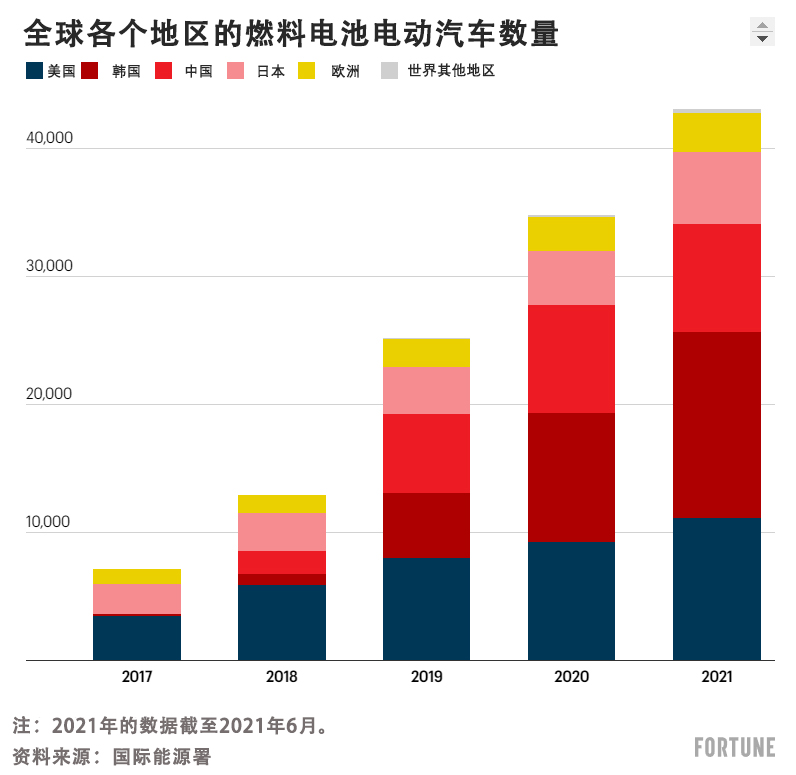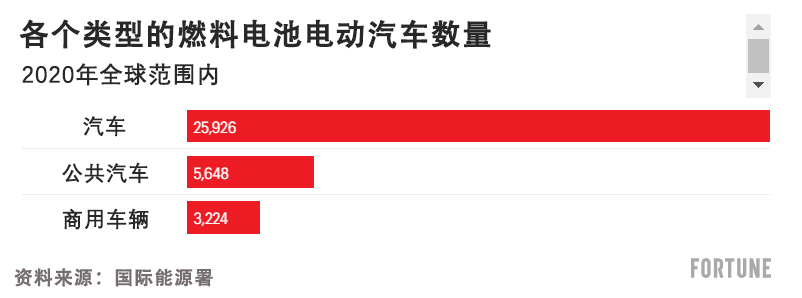埃隆·马斯克在最近的一次采访中称,氢燃料电池是“我能够想象到的最愚蠢的能源储存技术”。这是一项大多数人都没有听说过的技术。少数人就算听说过,八成也会联想到兴登堡号(Hindenburg)飞艇。这是一艘充满氢气的飞艇,在85年前起火爆炸,起火原因至今不明。
不过有能源专家表示,目前的氢燃料电池已经在安全性和效率方面取得了长足进步,有潜力在能源转型过程中扮演重要角色。
简单地说,这项技术就是从水或者碳化石燃料中提取氢,然后再逆转这个过程,在电化学电池中让氢原子和氧原子发生反应,产生电、水蒸气和热量。氢燃料电池的能源效率可以达到传统汽油发动机的两倍到三倍,它所需的电池也比一般的电动汽车小得多,因此有潜力为轻型卡车和重型卡车、火车、公共汽车、小型飞机、远洋船舶提供动力,甚至为医院和数据中心等场所充当备用电源。
阻碍氢燃料电池发展因素主要包括较高的制造成本、氢燃料灌注设施较少、生产绿色氢能的成本较高等等。但是这些情况已经开始有所改变了。
近日,丰田公司(Toyota)宣布将与五十铃(Isuzu)等厂商合作开发氢能源轻型卡车,并计划于明年在日本上市。雷诺(Renault)和现代(Hyundai)也正在测试氢电混动车型,而且近年来,这方面的专利数量也在飞速增长。随着研发投产规模的扩大,相关成本预计也将进一步下降。
美国总统乔·拜登签署了《降低通胀法案》(Inflation Reduction Act),其中一项内容就是为绿色氢能生产提供每千克3美元的税收抵免。绿色清能要比所谓的蓝色氢能(从天然气中提取)和灰色氢能(从煤炭中提取)干净得多。该法案还将扩大新能源汽车的税收抵免范围,预计会将氢燃料汽车包括在内,届时一辆电动汽车最高能够享受7500美元的税收抵免。
乘着新能源的东风
电动汽车正在迅速走进千家万户。但是在乘用车市场上,氢燃料汽车却显得入局太晚,规模也太小。截至2021年6月,全球上路的氢燃料汽车大约只有4万辆,还不到全球汽车总保有量的0.01%。
美国环境保护署交通与空气质量办公室(EPA’s Office of Transportation and Air Quality)的前主任、气候工作基金会(ClimateWorks Foundation)的研究员玛尔戈·奥格说:“对汽车市场,我非常怀疑。现在电动汽车已经赢得了这场比赛,目前路上的电动汽车已经达到了1500万辆。”

奥格表示,美国加利福尼亚州曾经试图投资燃料电池技术,但最终还是以失败告终,就是因为它过于依赖蓝色氢能,而且缺乏加氢站网络。“司机找不到给车加氢的地方。”
奥格认为,绿色氢能“在经济低碳化总体进程中可以发挥一定的作用”,但它主要将应用于乘用车以外的领域,比如发电、绿色钢铁生产,以及其他交通方式等。

到目前为止,所谓的绿色氢能是少之又少的,因为电解水技术十分耗能,而且成本很高,可供利用的可再生能源又不够。因此,目前占市场主流的仍然是不那么环保但却便宜很多的蓝色氢能。
奥格表示:“如果我们需要用更多的天然气来生产蓝色氢能,那我们就只是在延长化石燃料的寿命。”
良性竞争
也有一些乐观人士认为,氢能有利于交通的可持续发展,并且为电动汽车提供了一个替代选项。
位于美国印第安纳州的一家发动机制造公司康明斯公司(Cummins)的燃料电池和氢能技术副总裁艾米·亚当斯称,只要通过技术创新进一步降低成本,并且扩大加氢站网络建设,最多十年,氢燃料汽车就能够与传统汽车和电动汽车呈鼎足之势。
亚当斯指出,氢燃料汽车的增长可能会有相当一部分来自商用车市场,因为氢燃料汽车的能耗效率更高,比电动汽车更具优势。
“电动汽车的电池重量很大,因此需要牺牲一部分载重,这对物流公司来说很不划算。”她说。
亚当斯还表示,近年来,生产绿色氢能所需的可再生能源成本大幅下降,而材料与技术的进步“也降低了氢燃料电池的材料成本。”
在康明斯公司,亚当斯亲眼见证了氢燃料电池能耗效率的提高。这项技术现在已经可以带动200兆瓦的微电网,市场对电解装置的需求也在大幅提升,从而进一步降低了成本。去年,康明斯公司为法国铁路设备制造商阿尔斯通(Alstom)开发了专用燃料电池模块,使后者成功推出了全球首款氢动力电池列车Coradia iLint。
丰田的燃料电池解决方案团队的总经理道格拉斯·摩尔也看好氢燃料电池的潜力。他表示,对那种大载重、长旅程的重型卡车来说,“燃料电池解决方案显然更占优势,因为它能够满足物流公司为动力和续航里程的要求。”
除了应用在交通和电力领域,他认为,氢燃料电池技术“可以为碳中和做出积极贡献,而且能够以一种可再生的方式,促进人的交通。”
落基山研究所(Rocky Mountain Institute)的商用可再生能源中心(Business Renewables Center)的金融分析师帕特里克·莫洛伊指出,电动汽车和氢燃料汽车之间是一种“良性竞争”,它为我们提供了另一种选择,让人们可以在可适当的用途中选择氢能。
他说:“在有些用途中,其中一种技术或许比另一种更合适。我们的目标是促进整个交通系统转型,塑造一种商业上可行的零碳路径,并且在所有市场和所有领域部署。”(财富中文网)
译者:朴成奎
埃隆·马斯克在最近的一次采访中称,氢燃料电池是“我能够想象到的最愚蠢的能源储存技术”。这是一项大多数人都没有听说过的技术。少数人就算听说过,八成也会联想到兴登堡号(Hindenburg)飞艇。这是一艘充满氢气的飞艇,在85年前起火爆炸,起火原因至今不明。
不过有能源专家表示,目前的氢燃料电池已经在安全性和效率方面取得了长足进步,有潜力在能源转型过程中扮演重要角色。
简单地说,这项技术就是从水或者碳化石燃料中提取氢,然后再逆转这个过程,在电化学电池中让氢原子和氧原子发生反应,产生电、水蒸气和热量。氢燃料电池的能源效率可以达到传统汽油发动机的两倍到三倍,它所需的电池也比一般的电动汽车小得多,因此有潜力为轻型卡车和重型卡车、火车、公共汽车、小型飞机、远洋船舶提供动力,甚至为医院和数据中心等场所充当备用电源。
阻碍氢燃料电池发展因素主要包括较高的制造成本、氢燃料灌注设施较少、生产绿色氢能的成本较高等等。但是这些情况已经开始有所改变了。
近日,丰田公司(Toyota)宣布将与五十铃(Isuzu)等厂商合作开发氢能源轻型卡车,并计划于明年在日本上市。雷诺(Renault)和现代(Hyundai)也正在测试氢电混动车型,而且近年来,这方面的专利数量也在飞速增长。随着研发投产规模的扩大,相关成本预计也将进一步下降。
美国总统乔·拜登签署了《降低通胀法案》(Inflation Reduction Act),其中一项内容就是为绿色氢能生产提供每千克3美元的税收抵免。绿色清能要比所谓的蓝色氢能(从天然气中提取)和灰色氢能(从煤炭中提取)干净得多。该法案还将扩大新能源汽车的税收抵免范围,预计会将氢燃料汽车包括在内,届时一辆电动汽车最高能够享受7500美元的税收抵免。
乘着新能源的东风
电动汽车正在迅速走进千家万户。但是在乘用车市场上,氢燃料汽车却显得入局太晚,规模也太小。截至2021年6月,全球上路的氢燃料汽车大约只有4万辆,还不到全球汽车总保有量的0.01%。
美国环境保护署交通与空气质量办公室(EPA’s Office of Transportation and Air Quality)的前主任、气候工作基金会(ClimateWorks Foundation)的研究员玛尔戈·奥格说:“对汽车市场,我非常怀疑。现在电动汽车已经赢得了这场比赛,目前路上的电动汽车已经达到了1500万辆。”
奥格表示,美国加利福尼亚州曾经试图投资燃料电池技术,但最终还是以失败告终,就是因为它过于依赖蓝色氢能,而且缺乏加氢站网络。“司机找不到给车加氢的地方。”
奥格认为,绿色氢能“在经济低碳化总体进程中可以发挥一定的作用”,但它主要将应用于乘用车以外的领域,比如发电、绿色钢铁生产,以及其他交通方式等。
到目前为止,所谓的绿色氢能是少之又少的,因为电解水技术十分耗能,而且成本很高,可供利用的可再生能源又不够。因此,目前占市场主流的仍然是不那么环保但却便宜很多的蓝色氢能。
奥格表示:“如果我们需要用更多的天然气来生产蓝色氢能,那我们就只是在延长化石燃料的寿命。”
良性竞争
也有一些乐观人士认为,氢能有利于交通的可持续发展,并且为电动汽车提供了一个替代选项。
位于美国印第安纳州的一家发动机制造公司康明斯公司(Cummins)的燃料电池和氢能技术副总裁艾米·亚当斯称,只要通过技术创新进一步降低成本,并且扩大加氢站网络建设,最多十年,氢燃料汽车就能够与传统汽车和电动汽车呈鼎足之势。
亚当斯指出,氢燃料汽车的增长可能会有相当一部分来自商用车市场,因为氢燃料汽车的能耗效率更高,比电动汽车更具优势。
“电动汽车的电池重量很大,因此需要牺牲一部分载重,这对物流公司来说很不划算。”她说。
亚当斯还表示,近年来,生产绿色氢能所需的可再生能源成本大幅下降,而材料与技术的进步“也降低了氢燃料电池的材料成本。”
在康明斯公司,亚当斯亲眼见证了氢燃料电池能耗效率的提高。这项技术现在已经可以带动200兆瓦的微电网,市场对电解装置的需求也在大幅提升,从而进一步降低了成本。去年,康明斯公司为法国铁路设备制造商阿尔斯通(Alstom)开发了专用燃料电池模块,使后者成功推出了全球首款氢动力电池列车Coradia iLint。
丰田的燃料电池解决方案团队的总经理道格拉斯·摩尔也看好氢燃料电池的潜力。他表示,对那种大载重、长旅程的重型卡车来说,“燃料电池解决方案显然更占优势,因为它能够满足物流公司为动力和续航里程的要求。”
除了应用在交通和电力领域,他认为,氢燃料电池技术“可以为碳中和做出积极贡献,而且能够以一种可再生的方式,促进人的交通。”
落基山研究所(Rocky Mountain Institute)的商用可再生能源中心(Business Renewables Center)的金融分析师帕特里克·莫洛伊指出,电动汽车和氢燃料汽车之间是一种“良性竞争”,它为我们提供了另一种选择,让人们可以在可适当的用途中选择氢能。
他说:“在有些用途中,其中一种技术或许比另一种更合适。我们的目标是促进整个交通系统转型,塑造一种商业上可行的零碳路径,并且在所有市场和所有领域部署。”(财富中文网)
译者:朴成奎
When Elon Musk called hydrogen fuel cells “the most dumb thing I could possibly imagine for energy storage” in a recent interview, most people had probably never heard of the technology. And if they had, it’s likely they associated it with the Hindenburg, the hydrogen-filled airship that famously caught fire and exploded 85 years ago.
But hydrogen fuel-cell technology has come a long way in terms of safety and efficiency, and it could play a significant role in accelerating the transition away from fossil fuels, energy experts say.
Essentially, the technology works by extracting hydrogen from water or carbon fossil fuels and then reversing the process, combining hydrogen and oxygen atoms across an electrochemical cell to produce electricity, water vapor, and some heat. Fuel-cell technology is two to three times as efficient as a gas-powered engine. It also requires much smaller batteries than electric vehicles do and has the potential to power light and heavy-duty trucks, trains, buses, small aircraft and oceangoing vessels, as well as generate backup power for hospitals and data centers.
High manufacturing costs, a lack of refueling infrastructure, and the considerable expense of green hydrogen have held hydrogen back so far. But that is finally starting to change.
Toyota recently announced that it is teaming up with Isuzu and other partners to develop light-duty fuel-cell trucks, aiming to roll them out in Japan next year. Renault and Hyundai are testing hybrid electric-hydrogen vehicles, and patents on the technology have skyrocketed in recent years. As it scales up, costs are expected to drop further.
President Joe Biden signed the Inflation Reduction Act, which contains a landmark climate initiative that offers $3 per kilogram in tax credits for green hydrogen production. Green hydrogen is much cleaner than blue hydrogen, produced from natural gas, and gray hydrogen, produced from coal. The bill also expands the electric vehicle tax credit to include hydrogen fuel-cell vehicles—offering up to $7,500 for new EVs.
Riding electric’s tail
With widespread adoption of electric vehicles already underway, it might be too little too late for hydrogen fuel cells in the passenger car market. As of June 2021, there were only 40,000 fuel-cell electric vehicles (FCEVs) on the road around the world—less than 0.01% of the total stock of vehicles globally.
“When it comes to cars, I’m very skeptical. The race has been won by electric cars—of which there are 15 million on the road,” says Margo T. Oge, former director of the EPA’s Office of Transportation and Air Quality who now serves as a distinguished fellow at the ClimateWorks Foundation.
California made a concerted effort to invest in fuel-cell technology, but Oge says the initiative failed because it relied on blue hydrogen and lacked the infrastructure to support hydrogen cars: “Drivers couldn’t find places to fuel their vehicles.”
Oge believes that green hydrogen “has a role to play in decarbonizing the economy as a whole,” but for applications other than passenger cars, such as electricity, other modes of transportation, and green steel production.
Very little hydrogen is green so far, because electrolyzing water is energy intensive and costly, and there isn’t enough renewable energy available. As a result, less-sustainable blue hydrogen is still dominant and significantly cheaper.
“When we start investing in more natural gas to produce blue hydrogen, we just continue to extend the life of fossil fuels,” Oge says.
Healthy competition
Others are more optimistic about hydrogen’s potential to make transportation more sustainable and offer an alternative to electric vehicles.
Amy Adams, vice president of fuel-cell and hydrogen technologies at Cummins, an Indiana-based engine manufacturing company, predicts that hydrogen fuel-cell vehicles will reach parity with the traditional internal combustion engine, diesel, and electric by the end of the decade—as long as technological innovations bring costs down and the refueling infrastructure is built out.
Adams notes that much of this growth could come in commercial vehicles, where more efficient fuel cells have an advantage over the heavy batteries electric requires.
“If you reduce the amount of goods that trucks are able to deliver, that’s a bad business model for shipping companies,” she says.
Adams adds that the cost of renewable energy to produce green hydrogen has come way down in recent years, and advances in materials and technology have “reduced the material cost of the actual fuel cells.”
At Cummins, she’s seen the increase in fuel-cell efficiency up close. The technology is now able to power 200-megawatt microgrids, and demand for electrolyzers has grown significantly, further reducing costs. Last year, Cummins developed fuel-cell modules for French railway manufacturer Alstom, which introduced the world’s first passenger “hydrail,” the Coradia iLint.
Douglas Moore, general manager of Toyota’s fuel-cell solutions team, agrees about hydrogen’s potential. For heavy-duty trucks that require big payloads and go long distances, he says, “the fuel-cell solution is a clear winner, in the sense that it’s able to achieve that power in that range and that distance for those shipping customers.”
Along with other applications in transportation and power, he believes that hydrogen fuel-cell technology “can be a real contributor to carbon-neutral solutions and actually enable mobility through a very renewable process.”
As Patrick Molloy, a financial analyst at the Rocky Mountain Institute’s Business Renewables Center, puts it, the contest between electric and hydrogen fuel-cell technology is “good competition.” It will offer choice, ensuring that hydrogen is used wherever it is the better option.
“There are certain use cases that will provide stronger opportunities for one or the other,” he says. “The objective has to be transforming our total transportation system and making it a zero-carbon path that is commercially viable and deployable across all sections and segments.”






